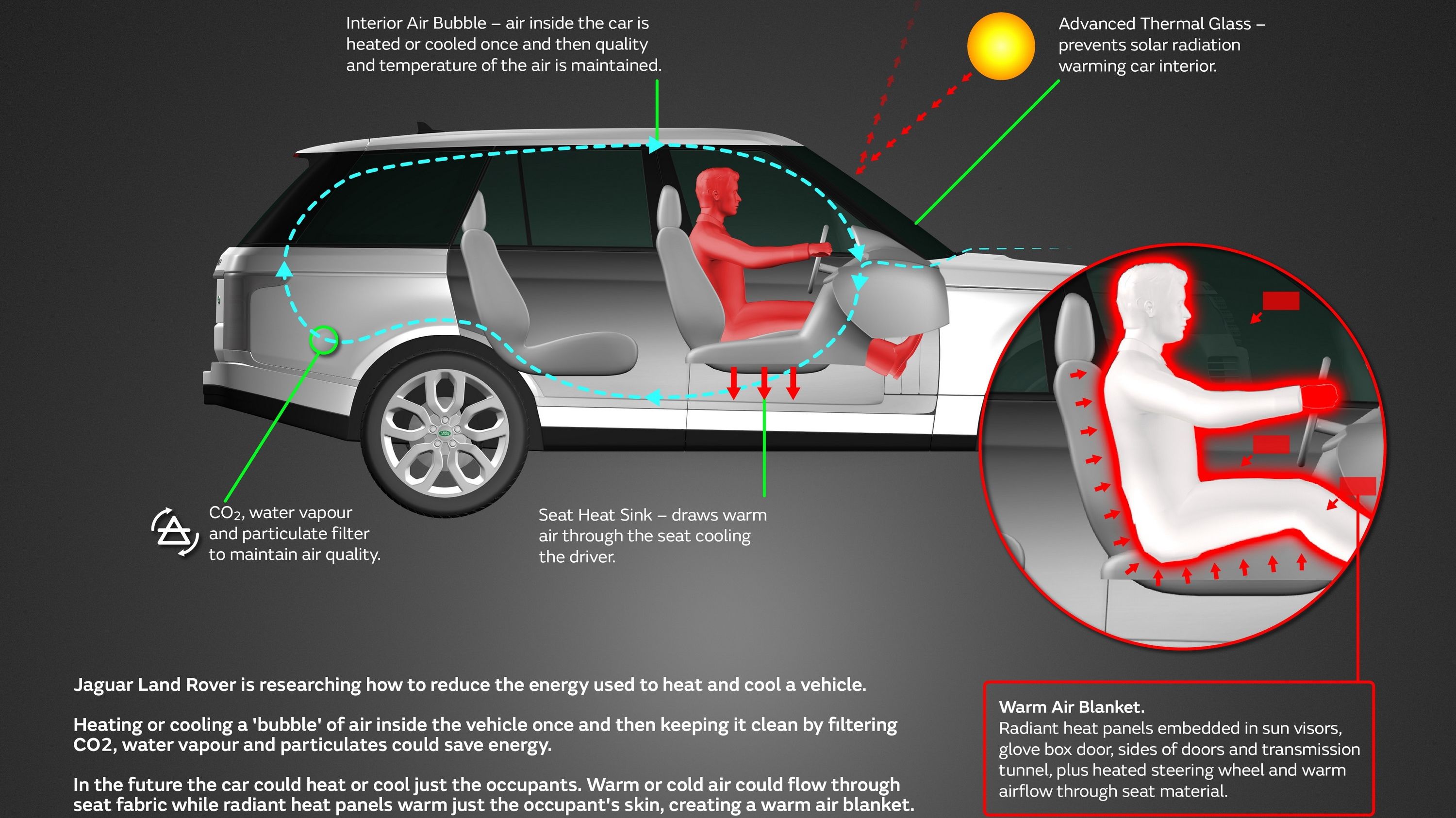In a recent press release, Jaguar->ke39 Land Rover->ke46 unveiled that it is looking into ways to reduce the amount of energy consumed by the current heating, ventilation and air-conditioning systems used in modern vehicles. According to JLR’s Director of Research and Technology, Dr. Wolfgang Epple, current HVAC systems can draw as much as 10 kW from the battery of electric vehicles, which can reduce electric range by up to 40 percent. Gasoline-powered vehicles also suffer from range loss, as air-conditioning can consume enough energy to reduce drive range by up to 20 percent.
Jaguar Land Rover has been researching how to heat or cool an air bubble inside the vehicle as opposed conditioning the entire cabin space. This would mean that compartments like the glove box and center console wouldn’t be conditioned by the HVAC system. Other areas like trunk space, areas under the seat, and even the area surrounding unused seats would also remain unconditioned. The air inside these so-called “air bubbles” would be passed through a special filter that would make the air quality better than that of the air outside the vehicle.
Another future innovation we may see from JLR is something they call the “Warm Air Blanket.” Instead of heating the air inside a vehicle, JLR wants to directly heat or cool each occupant directly. By using infrared panels strategically and invisibly placed around the vehicle, the skin of each occupant can be warmed instead of the air inside the cabin. The sensation of warmth would be almost immediate because of how quickly and efficiently the infrared panels work. The panels would be hidden inside the sun visors, glove box and center console doors, and on the floor around the transmission tunnel. Early tests results have apparently shown that this technology alone can reduce the energy consumption of a vehicle's HVAC system by 50 percent.
Other ideas include using infrared reflective (IRR) glass to prevent heating of the cabin by the sun’s rays, and by directing a flow of warm or cool air through porous surfaces in the seats. Since the direct effect of heating or cooling would be felt by vehicle occupants, it wouldn’t be necessary to operate the HVAC system constantly to maintain comfort. All of this is only part of what JLR is working on to reduce the energy consumption of all vehicles, and the emissions output of gasoline-powered vehicles. Read on to see what other innovations JLR has been working on.
Continue reading to learn more about this story.
The overall weight of a vehicle is critical to how much energy it takes to get it moving down the road. According to Dr. Epple, JLR engineers already lead the world in the development of lightweight vehicle bodies. Now those engineers have moved on to finding a way to reducing weight inside the vehicle as well. Everything has been taken into consideration -- from the material seats are made out of all the way down to the copper wiring used to carry electricity from one component to another.
If you were to crack open one of those new curved televisions, you wouldn’t see a bunch of wiring scattered around the case. You would see wafer-thin printed electronic circuits – one of the innovations that allow TVs to be so thin and lightweight compared to their older counterparts.
JLR has been researching whether or not it is feasible to use these printed circuits in place of most of the copper wiring inside a vehicle. The printed circuits would decrease the overall weight of the vehicle and would cut down on the space needed for electrical circuits. This alternative could be used for instruments inside the vehicle, lighting, heating and displays, and all of the switches inside the vehicle.
The other major innovation JLR is working on is called the Carbio Project. It is a project to expand the use of carbon fiber by making it cost-effective and environmentally friendly. By combining layers of carbon fiber and flax with cashew resin oil, JLR has done just that.
The combination brings the benefits of carbon fiber (lightweight and strength) with the low cost and sustainability of flax. Manufacturing cost is the same, but material cost of production is decreased by 33 percent. In addition to the lower cost, Carbio is half the weight of steel and a quarter the weight of aluminum. Components built with Carbio also require less sound-damping material, which means even more reduction of weight in the long run.
Why it matters
This research and development by JLR is huge for the future development of battery-powered, electric vehicles->ke1030. Most all-electric or plug-in hybrid->ke4486 vehicles outside of Tesla->ke1842 models have a very short all-electric range. By dropping the weight of interior components and the draw from climate control, manufacturers will be able to extend all-electric range. This will be a huge advantage for manufacturers who haven’t developed battery technology that can compete with the likes of Tesla. Just image what kind of range we can see from electric cars like Tesla’s 2015 Tesla Model S or 2016 Tesla Model X, or Mercedes future Model S fighter, if this kind of technology and weight reduction really can help to increase range on such a dramatic level. I’m looking forward to seeing where JLR goes with all of this research.

